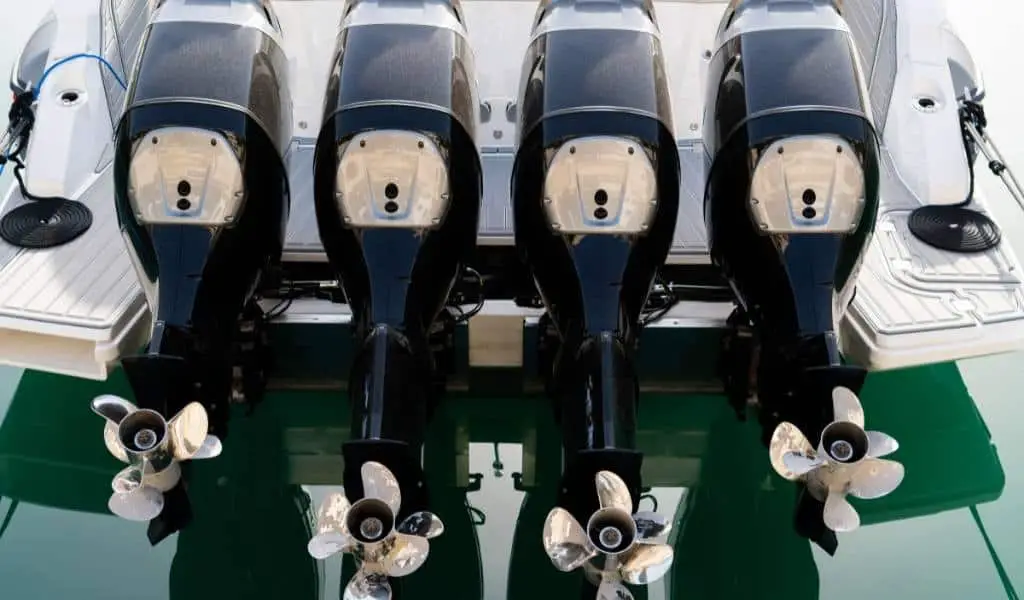One of the great things about an outboard motor is how versatile it is. An outboard motor can drive just about any sort of boat with proper mounting. Beyond motorboats designed for large outboards, you will see outboards hanging on the sterns of everything from small canoes to large cruising sailboats. Many single-engine boats mount a smaller auxiliary motor for emergency use.
No matter what size of boat you are running, one of the most critical choices you can make when buying an outboard motor is the shaft length. All boats are different, and the motor manufacturers produce a variety of standard lengths. Finding the right size is a matter of looking at what you’ve got and taking out the measuring tape. But, how do you measure it?
To measure your outboard motor shaft length, measure from the bottom of the mounting bracket where it rests on the transom to the top of the cavitation plate, this is the horizontal surface of the lower unit immediately above the propeller.
Later in the article is an image that shows you exactly where to measure. I’ll also explain the difference between short and long shafts and how they vary by type of boat.
Short vs. Long Shaft
Outboard motors can be fitted to a variety of boats, so manufacturers have standardized their engines to go on virtually anything. You can order an outboard in lengths ranging from 15 inches to 30 inches, depending on its power output and possible uses. Generally, short shaft outboards are 15 inches, long shaft outboards are 20 inches, and extra-long outboards are 25 inches.
Since the length of the shaft of your outboard is associated with the size boat, smaller engines will generally have shorter shafts. Small portable outboards ranging from 2 to 20 horsepower are usually sold only in short or long shaft versions. High powered boats usually only come in long and extra-long variants. For really big boats, the biggest and baddest six- or eight-cylinder outboards can have “extra-extra long” shafts up to 30 inches.
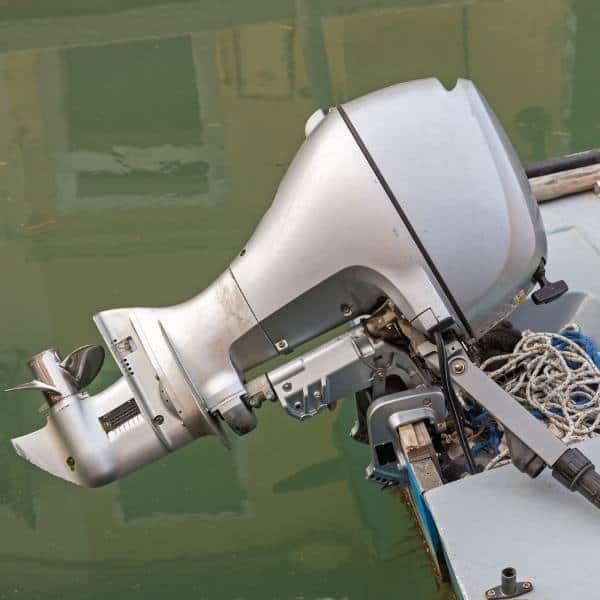
Amazon has plate extensions to allow adjustments without buying a new motor: T-H Marine Jack Plate Extension
Typical motor lengths include the following.
- Short shaft–15 inches
- Long shaft–20 inches
- Extra-long shaft–25 inches
- Extra-extra long shaft–30 inches
There are also specialty motor shaft lengths. Small motors built for sailboats might come in a unique configuration with an extremely long shaft since these are mounted higher off the water. The same is true for the newest, high-powered offshore fishing boats, where triple or quadruple motor setups are becoming more and more common.
It’s important to note that manufacturers call their models different things. Some may call it a “standard” length while others may call it a short or a long shaft. What matters is the actual measurement in the specifications, not the name.
Selecting the Correct Size Outboard Shaft
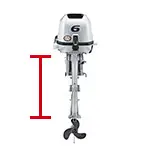
The correct shaft length for your boat depends on a few factors. The first order of business is to measure your boat for the ideal fit. Once you know what will fit on your hull, you can fine-tune your choice based on the performance you’re looking for and how you use the boat.
Ideally, you want the outboard’s cavitation plate, also called the anti-ventilation plate, to be at the same level as the bottom of your hull. This will ensure the best performance. How the outboard will sit on the back of the boat depends on how the transom is designed. Some boats are equipped with transom-hung outboards while others have a bracket.
Having the cavitation plate too low will cause excess drag and reduced performance at high speeds. For slower boats, it’s less critical to
Shaft Length by Type of Boat
Picking the right shaft length is mostly a factor of the transom height or the back of the boat. But in many cases, it’s a little more complicated than that alone. Boat hulls are designed in three basic types that range from slow displacement and semi-displacement hulls to the fastest planing hulls.
If you are running a slower boat, the exact location of the ventilation plate is less important. Having the cavitation plate a bit lower than the transom is preferable to having it too high. This will keep the prop in the water when the boat pitches in waves, or hobby-horses. Workboats, sailboats, and displacement-hulled boats fall into this category. On this type of boat, if you are in doubt, default to the longer-shafted outboard.
The faster your boat, the more critical it is to get the sizing just right. If your boat planes, pay extra attention to getting the shaft length as close to perfect as possible. An inch or two probably won’t make a big difference, but any more than that will lead to trouble. Problems with getting the ventilation plate too low include slower hole-shot and lower top-end speeds. Bass boats, ski boats, or center cockpit vessels will want to double-check their measurements to get it just right. The performance of these boats depends on quite a lot of factors, but getting the outboard length just right is an essential first step.
Jack Plates and Transom Brackets
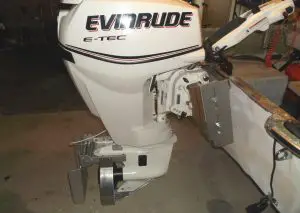
Many boat transoms are modified to use a different length of outboard by using a bracket. Offshore vessels are often equipped with a large mounting bracket so that the transom can be left at full height. This provides seaworthiness and offers maximum protection from large seas. These allow the mounting of a standard length outboard behind the transom.
Smaller boats may use adjustable jack plates that can be changed to fit any outboard. Sailboats use these sometimes, as well as some boaters who want to install a much smaller auxiliary motor to use in case of primary engine failure. Brackets are also handy for boats that do not have flat transoms, like canoe-stern sailboats or fan-tailed motor vessels.
Beefier jack plates can be fitted should a boater be looking to mount an outboard with a shorter shaft than their transom demands. They’re also useful if the back of your boat has a non-standard measurement. With a jack plate, you can mount it exactly where you want it.
How to Measure Transom Height
For vessels with transom-mounted outboards, you can easily figure out which type of outboard you need to get. Measure from the top of the transom to the bottom of the hull. Your goal is to measure how the outboard will sit, so start from the clamping plate and follow the centerline of the hull. Measure straight down to the lowest point on the hull. For vee-shaped hulls, the lowest spot of the hull will come to point, while on flat-bottomed boats it will be more or less level. The lowest point will likely be directly under your drain plug if you’ve got one.
If you are running a twin-engine setup, then measure the same distance from each clamping plate to the bottom of the hull. This number will likely be shorter than that for a single-engine installation since you do not necessarily measure to the point of the keel.
For boats equipped with a bracket, calculate the same measurement but based on the bracket and not the transom. Wherever the outboard clamping bracket is, use this as the basis for measurement.
If your boat is newer and the manufacturer is still in business, you might also want to try to give them a call. Chances are the boat was designed with a specific size of outboard in mind. If you are looking to repower, they may be able to offer some sage advice. Check the literature about your model boat online, and you may be surprised to find that the number is published for you. It’s still smart to measure it yourself though, just in case, the design changed over the years. With such an important, long-term, and expensive upgrade, it’s never a bad idea to double-check.
How to Measure an Outboard Shaft
If you’re going the other way around and trying to figure out how long the shaft on your outboard is, measuring it is equally easy. This is handy if you’re shopping for second-hand outboards or looking to sell the one that came with your boat.
Use the mounting bracket on the motor to know where it will sit on the boat. The flat part of the bracket that rests on the transom when mounted will give you the same point of reference as the transom does on the boat. Measure from there down to the top of the cavitation plate, also known as the anti-ventilation plate. The cavitation plate is the horizontal surface of the lower unit immediately above the propeller.
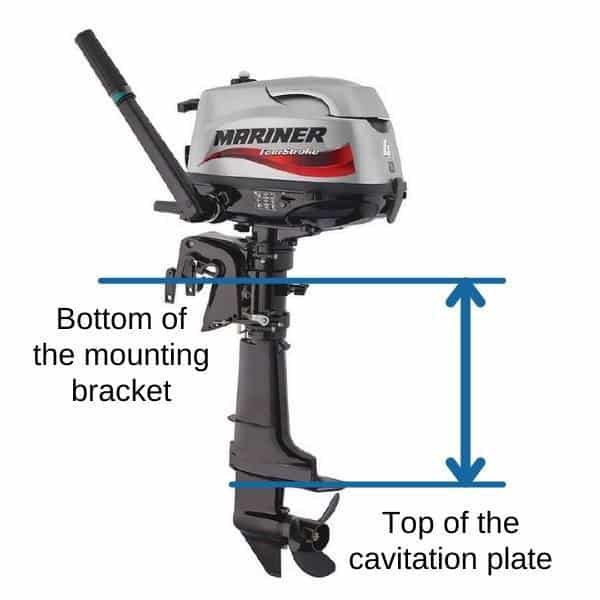
If you’d like to see this in video format, skip to 0:44 in the below YouTube Video:
FAQs About Outboard Shaft Length
Is it OK to put a long shaft outboard on a boat that’s rated for a short shaft?
A: The short answer is – Yes. You can use a longer shaft than recommended and your boat will work fine. However, your boat will have slightly more drag which will reduce your maximum speed. You’ll also want to pay attention when you’re in shallow water because your prop will be lower than normal
What types of boat need a short shaft?
A: The answer varies by boat, but here are some rules of thumb for matching a short shaft outboard to your boat. If you have a small boat with a 15 to 17 inch aft transom, you’ll most likely need a short shaft outboard. Other boats that need short shafts are:
- Small Sailboats and small Jon boats
- Sailboats with movable brackets
- Zodiacs and other inflatables
- Canoes
What types of boat need a long shaft?
A: If you have a small boat with a 18 to 21 inch aft transom, you’ll most likely need a long shaft outboard. Other boats that need long shafts are
- Sailboats and small Jon boats
- Pontoon boats
- Carolina Skiffs
What types of boat need an extra long shaft?
A: Any boat that has a 21 to 27 inch aft transom will need an extra long shaft outboard. Other boats that need extra long shafts are:
- Sailboats
- Barges that need a lot of thrust
- Boats with a high transom
Read my other articles on outboard motors.
- Picking the Best Small Outboard Motor
- How Long Should an Outboard Motor Last
- Twin Outboards on Small Boat – Key Facts
- What is the Best Outboard Motor for Saltwater
Conclusion
Picking the right shaft length for your outboard is an essential step in getting the best performance from your boat. If you have a fast boat, getting the outboard’s cavitation plate at the same level of the hull will ensure quick hole shot and fast top-end speeds. Owners of bass boats, RIBs, or offshore fishing boats need to get this right. It will ensure that the outboard’s trim will be effective, and it will save you gas too.
Displacement hulled vessels like sailboats and workboats can benefit from a little more space between the hull and cavitation plate, but not much. Remember, if you use a longer outboard shaft than you need you will be increasing your draft. You also might not be able to lift the outboard out of the water entirely for storage.
Repowering your boat is one of the most expensive upgrades you can make. Be sure to measure carefully and research thoroughly before diving in. Happy boating!

